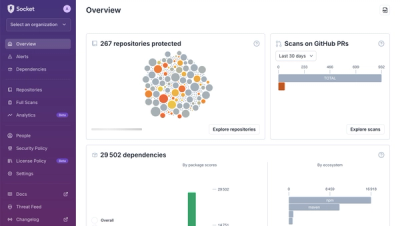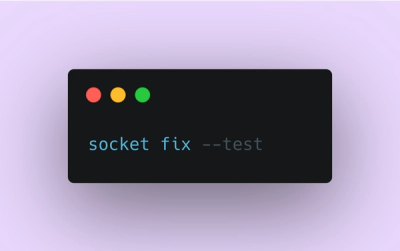
Research
Using Trusted Protocols Against You: Gmail as a C2 Mechanism
Socket uncovers malicious packages on PyPI using Gmail's SMTP protocol for command and control (C2) to exfiltrate data and execute commands.
leaky-bucket
Advanced tools
A fast and efficient leaky bucket for node.js and the Browser
Leaky buckets are often used to rate limits calls to APIs. They can be used on the server, to make sure the client does not send too many requests in a short time or on the client, to make sure to not to send too many requests to a server, that is rate limiting using a leaky bucket.
Leaky buckets are burstable: if a server lets a client send 10 requests per minute, it normally lets the user burst those 10 requests in a short time. After that only one request every 6 seconds may be sent (60 seconds / 10 requests). If the user stops sending requests, the bucket is filled up again so that the user may send a burst of requests again.
New in Version 4:
npm i leaky-bucket
import LeakyBucket from 'leaky-bucket';
// a leaky bucket, that will burst 60 items, then will throttle the items to one per seond
const bucket = new Bucket({
capacity: 60,
interval: 60,
});
The capacity defines how many requests may be sent oer interval. If the capacity is 100 and the interval is 60 seconds and a request has a cost of 1, every 60 seconds 1000 request may be processed. If the request cost is 4, jsut 25 requests may be processed every 60 seconds.
The complete capacity can be used in a burst. This means for the example above, 100 requests can be processed immediately. Thereafter every request has to weit for 0.6 seconds (60 seconds / 100 capacity) if the request cost is 1.
The interval defines, how much seconds it takes to refill the bucket to its full capacity. The bucket is not filled every interval, but continously.
Normally, the bucket will throw errors when the throttle() method is called when the bucket is empty. When a timeout is defined, the bucket will queue items as long they can be executed within the timeout. Defaults to 0, which will not queue any items if the bucket is empty.
Some rate limited services will start out with an empty bucket, or refill the bucket not continusly but in an interval. This option can be used to set a starting capacity beween 0 and the configured capacity. If set to 0 and a request shall be processed immediately and the timeout is 0, the bucket will reject the request.
If this option is set, the bucket will emti a idleTimeout event after the bucket is filled completely and no requests are waiting. Configured in milliseconds.
If set to true, the bucket will print debug logs using console.log()
This is the main method used for procsessing requests. If this method is called and the bucket has more capacity left that the request costs, it will continue. If the capacity is less than the cost, it will throw an error. If the timeout option is configured, the method will sleep until there is enough capacity to process it.
This method accepts two optional parameters:
// throttle an individual item
await bucket.throttle();
doThings();
// Throttle a set of items, waiting for each one to complete before the next one is executed
for (const item of set.values()) {
await bucket.throttle();
doThings();
}
// throttle multiple items and wait untiul all are finished
await Promise.all(Array.from(set).map(async(item) => {
await bucket.throttle();
doThings();
}));
The pause method can be use to pause the bucket for n seconds. Same as the throttle call but does not throw errors when the bucket is over its capacity.
bucket.pause(2);
The pause method can be use to pause the bucket for a specific cost. Same as the throttle call but does not throw errors when the bucket is over its capacity.
bucket.pauseByCost(300);
Removes the defined cost from the bucket without taking any action. Reduces the current capacity.
bucket.pay(cost);
Shuts down the bucket, clears all timers. Removes all pending items wihtout executing them. The bucket cannot be reused thereafter!
bucket.end();
Returns the total capacity of the bucket.
const capacity = bucket.getCapacity();
Returns the current capacity of the bucket.
const currentCapacity = bucket.getCurrentCapacity();
Sets the amount of seconds the bucket queue items before it starts to reject them. Same as the timeout option in the constructor
bucket.setTimeout(300);
Sets the interval it takes to refill the bucket completely. Same as the interval option in the constructor
bucket.setInterval(60);
Sets the capacity of the bucket. Same as the capacity option in the constructor
bucket.setTimeout(1000);
This event is emitted, if the bucket is at full capacity and idle for N milliseconds
const bucket = new Bucket({
capacity: 60,
interval: 60,
});
bucket.on('idleTimeout', (bucketInstance) => {
bucket.end();
});
// you may remove the listener if you want
bucket.off('idleTimeout');
This event is emitted, when the bucket is idle, thus no items are waiting to be executed.
const bucket = new Bucket({
capacity: 60,
interval: 60,
bucket.on('idle', (bucketInstance) => {
console.log('bucket is idling');
});
// you may remove the listener if you want
bucket.off('idle');
Removes all or one listeners for an event
const bucket = new Bucket({
capacity: 60,
interval: 60,
});
// remove all listeners for the idle event
bucket.off('idle')
const listener = (bucketInstance) => {
console.log(bucketInstance.getCurrentCapacity());
}
bucket.on('idle', listener);
// remove one specific listener
bucket.off('idle', listener);
The bucket can used in the Browser. Import src/LeakyBucket.js for that usecase.
In order to debug the internals of the bucket you may enable debugging by passing the debug flag to the constructor.
const bucket = new Bucket({
capacity: 60,
interval: 60,
debug: true,
});
If you'd like to throttle incoming requests using the leaky bucket with express, you may register it as middleware. The example below shows a bucket per user, identified by a cookie identifying the user. The bucket gets deleted after a user has not sent requests for 2 minutes.
import LeakyBucket from 'leaky-bucket';
import express from 'express';
const app = express()
const buckets = new Map();
const costOfOperation = 50;
app.use((req, res, next) => {
// your cookie should be secure and not guessable by the user
const userUid = req.cookies.userUid;
// set up a bucket for the user
if (!users.has(userUid)) {
const bucket = new Bucket({
capacity: 1000,
interval: 60,
idleTimeout: 120 * 1000 // 120 seconds
});
// end the bucket, remove it from memory when it becomes idle
bucket.on('idleTimeout', () => {
bucket.end();
buckets.delete(userUid);
});
// store for later access
buckets.set(userUid, bucket);
}
// get the users bucket
const usersBucket = buckets.get(userUid);
try {
// try to execute the request, if the bucket is empty, it will throw an error
usersBucket.throttle(costOfOperation);
} catch (e) {
// bucket is over capacity
res.status(420).send(`Enhance your calm!`);
return;
}
// all set and fine, continue to process the request
res.set('x-rate-limit-cost', costOfOperation);
res.set('x-rate-limit-bucket-size', bucket.getCapacity());
res.set('x-rate-limit-remaining-size', bucket.getCurrentCapacity());
next();
});
app.listen(8080);
FAQs
A fast and efficient leaky bucket implementation
The npm package leaky-bucket receives a total of 6,052 weekly downloads. As such, leaky-bucket popularity was classified as popular.
We found that leaky-bucket demonstrated a not healthy version release cadence and project activity because the last version was released a year ago. It has 1 open source maintainer collaborating on the project.
Did you know?

Socket for GitHub automatically highlights issues in each pull request and monitors the health of all your open source dependencies. Discover the contents of your packages and block harmful activity before you install or update your dependencies.

Research
Socket uncovers malicious packages on PyPI using Gmail's SMTP protocol for command and control (C2) to exfiltrate data and execute commands.

Product
We redesigned Socket's first logged-in page to display rich and insightful visualizations about your repositories protected against supply chain threats.

Product
Automatically fix and test dependency updates with socket fix—a new CLI tool that turns CVE alerts into safe, automated upgrades.